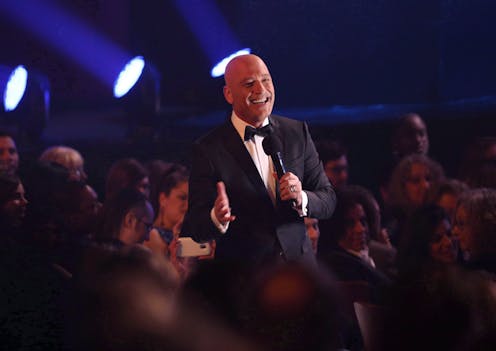
Recently at a Winnipeg comedy club, American comic Rich Vos hurled racist “jokes” at female Indigenous attendees — lobbing lines like he hoped the women would get ticketed for driving under the influence on the way home.
Vos’s antics further a longstanding practice of spewing bile and ignorance disguised as entertainment.
As a researcher and a stand-up comedian myself, I see that comedy’s greatest power actually isn’t to bully and divide, but rather to unite and heal.
It should be deployed to help propel truth and conciliation among Indigenous and non-Indigenous people, not derail it.
Why we laugh
Scholars commonly offer three theories on why we find things funny.
First comes ridicule — the notion that we, the audience, are superior to the butt of the joke. Insult comics like Vos ride this oldest train of thought, freighted as it may be.
The second theory is surprise, the joyous incongruity awaiting us when the rug is yanked from under us.
The third is relief, the physical catharsis from releasing our pent-up emotions. Sigmund Freud couched this as repressed psychic energy.
If this trifecta has a common denominator, it could be duality: us vs. them, expectation vs. surprise, repression vs. release. Aristotle echoes this in seeing comedy as the converse of tragedy, a dualism echoed by even more recent comics like Steve Allen defining comedy as tragedy plus time and John Vorhaus positing that comedy equals truth plus pain.
Maybe that’s why comedy thrives in our hours of greatest need: when we, individually or as a society, are in pain.
Comedy for survival
Being what the great Ojibway writer Drew Hayden Taylor calls “a person of pallor” — white — I can’t imagine the historic and present pain suffered by Indigenous people due to colonialism.
But I can certainly appreciate how turning to comedy has helped Indigenous people and others resist their oppressors. Kanien’kehá:ka actor Devery Jacobs declares: “Indigenous people are masters at taking the hurt and pain that was dealt to us, laughing in the face of it and weaving it into ridiculous comedy gold.”
This mirrors the legendary Jewish penchant for comedy as a means of coping with centuries of persecution and genocide, manifested in a sub-genre dubbed “Holocaust humour” and documented in Israeli scholar Chaya Ostrower’s in-depth study of Holocaust survivors, It Kept Us Alive.
Taylor observes that the ability to laugh has not only kept Indigenous people sane, but also given them power, “sort of like a spiritual pemmican.” The Toronto-based, all-Indigenous female comedy troupe Manifest Destiny’s Child deploys comedy to share lived experiences and to heal. Anishinaabe Comedian Tim Fontaine shows us that dark comedy can bring the light of understanding as a path to change.
In Subversive Laughter: The Liberating Power of Comedy, comedian Ron Jenkins documents cases where the form has been deployed to survive and even overcome tyranny.
He describes clowns in Bali who stage theatre against Westernization by tourists. Lithuanian street artists who decorate Russian barricades with caricatures of Stalin and Lenin. A khaki-clad clown who leads an anti-apartheid march in South Africa. Comic theatre artists who mock the widespread intolerance of eccentricity in Japan.
My ancestors come from Hungary, located in central Europe with limited natural defences and thus a hotspot for armed tourism by Mongol, Turkish, Austrian, Nazi and Soviet occupiers. My parents, then young political refugees of the Hungarian Revolution, still recall standing in a breadline in Budapest, sharing jokes about Russians while around the corner, Soviet tanks terrorized the streets. Growing up as a child of immigrants, I found comedy to be an essential survival tactic on the playground.
Controlling public discourse
Cultural theorist Susan Purdie sees the real role of comedy as controlling language and meaning. So when comedians command a podium, they don a mantle of power.
I argue that ethically, in civil society, this mantle should come with a responsibility not to abuse it. Comedy’s societal credibility and contribution — its proven power as a force for positive change — comes from punching up rather than kicking down.
Comedy is a social corrective exposing the gap between what is (injustice, poverty, environmental disaster) and what some think it ought to be (fairness, equal opportunity, gentle breezes). This gap, which may be history’s largest mass case of cognitive dissonance, remains our omnipresent duality.
In addressing this gap to inspire positive change, comedy promotes new ideas and offers hope. That entails punching up at privilege to call out abuse, not kicking down to perpetuate it.
Racial slurs like those belched by Vos at Indigenous audience members channel Roman emperors cracking wise about emaciated Christians making lame lunches for the lions. Vos admitted a further cardinal sin in comedy in professing no knowledge of the violence facing Indigenous women in Winnipeg, which boasts the largest Indigenous population in Canada: no research!
So what does all this teach us about the role of comedy in public discourse?
We might think of the comedian’s loftiest task as being to “speak the truth, but not to punish.” But comedy can serve as a corrective, a cream-pie balm for a societal rash, nudging us towards a kinder way to live.
At its best, comedy can bridge, unite and heal, rather than divide, bully and perpetuate the very ills that it is uniquely equipped to help us solve. At its core (even in addressing our many flaws) comedy, like its timeless tool, the whoopee-cushion, should lift us all up.
Geo Takach receives funding from the Social Sciences and Humanities Research Council, an agency of the Government of Canada.
This article was originally published on The Conversation. Read the original article.







